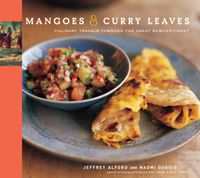Moghul
By Jeffrey Alford and Naomi Duguid
Published 2005
The Muslim rulers of Central and West Asia began invading the Subcontinent in about the tenth century. By the time the great Moroccan traveler Ibn Battuta (see Bibliography) got to Delhi in 1338, most of northern India, from the Indus River to Lucknow, was controlled by a Muslim ruler based in Delhi. In the 1500s, the Moghuls, descendants of the Mongols, ruled Iran and parts of Afghanistan and took control of these northern kingdoms. Moghul culture, including its culinary traditions, was elaborate and refined, a blend of Central Asian and Persian cultural traditions. Moghul traditions were, of course, adapted and refined still further once they reached the Subcontinent, incorporating new ingredients. The cities of Delhi, Agra, Hyderabad, and Lucknow are particularly known for their Moghul-influenced cuisines. Because Moghul cuisine was the cuisine of the conquerors, it had, and still has, a special status in much of India and Pakistan—rather as French cuisine did, and still does, in much of Europe and North America. Dishes associated with Moghul tradition include biryani and pulao, and many sweets, from jalebi to gulab jamun and kulfi (see Mango Ice Cream with Cardamom). Ingredients often include almonds, pistachios, or raisins, and spices such as cinnamon, cloves, and cardamom.
Part of
Advertisement
Related Recipes
-
-
-
-
Related Reference
-
-
-
-
Advertisement




